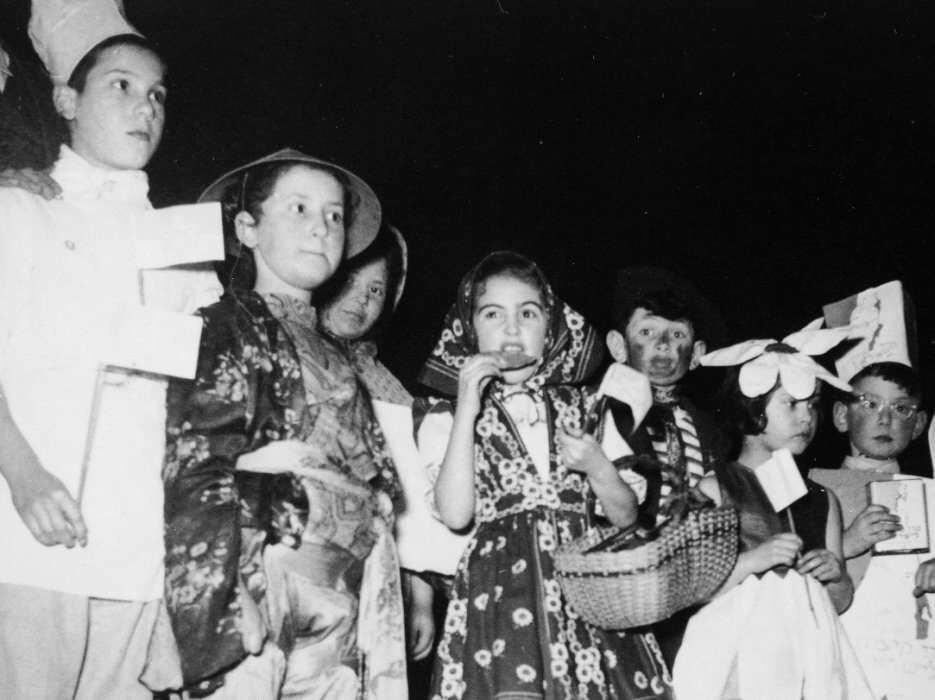
The Holocaust in the Netherlands: Individuals--Alfred Münzer

Figure 1.--These Dutch Jewish children dressed in costumes for Purim. Among those pictured are Alfred Münzer and Roosje Einhorn, both survived the NAZI Holocause because they were hidden by incredibly brave Dutch people. This photograph was taken shortly after the War, probably in 1946. Alfred is the little boy with glasss at the right.
|
|
Alfred Münzer was born in the Hague (November 1941). His father, Simcha, before the War owned a men’s tailoring shop. His mother, Gisele, was ahome keeper. He had two older sisters, Eva and Leah. After the German invasion (1940), German officials began taking anti-Semetic actions, including seizing bank accounts and property. After Gisele became pregnant they had a very difficult decesion tomake. The Germans also begn compiling names and addresses of Jews and concentrating them in easily accessable locations. When the death canps were ready in Poland, the tranports began (1942). Authorities ordered Alfred’s father to report to a German labor camp which was a ruse for transport to a death camp (May 1942). He managed to delay reporting scheduling a hernia operation. Strange as it may seem, the Germans at this early stage only wanted healthy males. Simcha decided that the fmily would have to go into hiding (September 194). He faked a suicide attempt in get himself committed to a psychiatric hospital near The Hague. Gisele sold the family’s few remaining possessions and arranged for friends and neighbors to take in the children. She then joined her husband as a nurse nurse’s assistant in the psychiatric hospital with her he husband. Thus they managed to evade the German's for a few more months. Alfred’s parents were finally arrested and held in Herzogenbusch concentration camp near Vught (early-1943). This was a rare SS camp in Western Europe. It was a holding camp located in the southern Netherlands. Conditions were poor, but theywere together. They were next sent to Auschwitz and separated (1944). Simcha was sent to Mauthausen (January 1945) and then a number of other camps. He was finally liberated at Ebensee, but tragically was in such poor health that hedied 2 months later at a nearby convent that was caring for him. Gisele was sent from Auschwitz to work at one of the Telefunken factories near Reichenbach. The factory was bombed (summer 1944). She was then marched to a series of concentration camps, ultimately arriving at Ravensbrück. The Swedish Red Cross was permited to rescue some concentration camp inmates (spring 1945). After the War she repatriated to the Netherlands (August 1945). The girls had been placed with the friend of a neighbor. The woman's husband denounced ger (early1944). The German occupation authorities arrested ll three and interned them at Westerbork--a transport camp. The girls, 8-year old Eva and 6-year old Leah were deported to Auschwitz (February 1944). They were murdered 3 days later. Alfred had been placed with a friend named, Annie Madna, who asked her sister to care for him. She became afraid even though as a veryyoi=ng blond boy he was fairly easy to hide, but the consequences were drcinian. So after a month, Annie placed Alfred with her ex-husband--Tolé Madnas. This was much more dangerous as Tolé was Indonesian and a little blond boy stood out. Alfred was taken into Tolé’s home. Their housekeeper, Mima Saïna, looked after him and Alfred came to think that she was his mother. The Madnas treated Alfred as one of their own children, only he was not allowed to go outdoors. Blond-haired, blue-eyed Alfred did not seem to notice that he did not look like his new family, but aoppearing outside with them would have resulted in very dangerous questions. The Dutch people for the most part id not copperate with the Grmns, but there were collaborators which cost Alfred's sisters their lives. He was hiden in the cellar when people came to the house. When Gisele returned for Alfred after the War, the 4-year-old had no idea who she was. Gisele decided to ease the transition. She asked Mima to continue caring for him for a while. Mima died, however, a few months later and Gisele was reunited with her son. Then when Alfred was 6-years old his mother opened a cosmetics store. They moved to Belgium (1952). Finlly they emigrated to the United States (1958). Alfred studied medicine and became an internist and pulmonologist. He has maintained a close relationship with Tolé’s children.
CIH -- WWII Holocaust

Navigate the CIH World War II Holocaut Section:
Return to Main Dutch Holocaust individuals page]
[Return to Main Dutch Holocaust page]
[About Us]
[Allies]
[Biographies]
[Children]
[Concentration camps]
[Countries]
[Decision]
[Denyers/Apologists]
[Displaced persons]
[Economics]
[Eisatzgruppen]
[Eugenics]
[German Jews]
[Ghettoes]
[Impact]
[Justice]
[Literature]
[Movies]
[NAZIs]
[Occupied Poland]
[Process]
[Propagada]
[Resistance]
[Restitution]
[Questions]
[SA]
[SS]
[Special situations]
[Targets]
[Wansee Conference]
[Return to the World War II]
[Return to Main Holocaust page]
[Return to the Main mass killing page]
[Return to CIH Home page]
Created: 7:07 PM 11/2/2015
Last updated: 7:07 PM 11/2/2015



